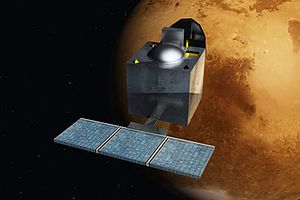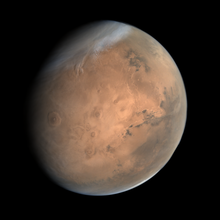Mars Orbiter Mission
| Mars Orbiter Mission | |||||||||||||||||||||||||||||||
|---|---|---|---|---|---|---|---|---|---|---|---|---|---|---|---|---|---|---|---|---|---|---|---|---|---|---|---|---|---|---|---|
 Artist's impression of MOM in Mars orbit |
|||||||||||||||||||||||||||||||
| NSSDC ID | 2013-060A | ||||||||||||||||||||||||||||||
| Mission goal | Orbiting and remote sensing of Mars | ||||||||||||||||||||||||||||||
| Client |
|
||||||||||||||||||||||||||||||
| Launcher | PLSV-XL C-25 | ||||||||||||||||||||||||||||||
| construction | |||||||||||||||||||||||||||||||
| Takeoff mass | 1337 kg | ||||||||||||||||||||||||||||||
| Instruments | |||||||||||||||||||||||||||||||
|
LAP, MSM, MENCA, MCC, TIS |
|||||||||||||||||||||||||||||||
| Course of the mission | |||||||||||||||||||||||||||||||
| Start date | November 5, 2013, 09:08 UTC | ||||||||||||||||||||||||||||||
| launch pad | SHAR FLP | ||||||||||||||||||||||||||||||
|
|||||||||||||||||||||||||||||||
Mars Orbiter Mission ( MOM ), unofficially also called Mangalyaan ( Hindi मंगलयान (IPA: məŋɡəljaːn) 'Mars vehicle') in the media , is a space mission of the Indian space agency ISRO . As part of this mission, the Mars Orbiter probe flew to the planet Mars .
Mission objectives

The main objective of the mission was to successfully enter a stable orbit around Mars. Other tasks include testing deep space communication and navigation, planning and carrying out an interplanetary mission, and integrating the probe's autonomous functions to bridge emergency situations.
Mangalyaan was to orbit Mars for at least six months and use its solar-powered instruments to study the red planet's weather. As a side effect, the Indian scientists hope to gain knowledge about the whereabouts of the once liquid water on the surface and about the methane contained in the atmosphere.
Planning and preparation
The leadership team of the mission consists of Mylswamy Annadurai as program director, S. Arunan as project manager and S. K. Shivkumar as his deputy. The probe took 15 months to develop. The assembly of the system components with the PSLV-XL rocket took place from August 5, 2013 at the ISRO Satellite Center in Bangalore, Karnataka. On October 2, 2013, the rocket was transported to the launch site in Sriharikotta in the state of Andhra Pradesh.
The mission envisaged a total duration from the start date of at least 16 months. In September 2015, however, it became known that the fuel consumption of the probe was lower than expected and that the mission could therefore be continued for at least 15 years .
Mission history
The probe was launched on November 5, 2013 at 9:08 a.m. ( UTC ) with a PSLV-XL rocket from the Satish Dhawan Space Center in Andhra Pradesh . Initially, it swung into orbit around the earth . Then on November 30, 2013, with the main engine burning for 22 minutes, it left its orbit and set course for Mars. On September 24, 2014, it reached Mars, there is a strong elliptical orbit at an altitude of 500 × 80,000 km. On September 25, 2014, the transmitted a first color photo of the Martian atmosphere, which was taken with the Mars Color Camera (MCC) from an altitude of 8,449 km.
One year after the start of the mission, on September 24, 2015, ISRO published a 120-page “Mars Atlas” with selected images of the mission.
technology
The structure of the Mars probe is based on the experience with IRS / INSAT / Chandrayaan-1 and has been adapted to the requirements. The central cylinder is made of aluminum and carbon fiber reinforced plastic (CFRP) , the panels of metal honeycomb and CFRP. The structural components were manufactured by Hindustan Aeronautics (HAL) in Bangalore; the basic structure and the subsystems of the Mars orbiter were assembled in the ISRO Satellite Center (ISAC) in Bangalore, where the scientific payload was also installed.
Eight control nozzles with 22 Newtons of thrust each , four reaction wheels for position control , the three-part solar cell panels and one medium gain (MGA), one high gain (HLA) and TT&C antenna (HGA) are grouped around the centrally installed fuel tank and the main engine . The HGA antenna with a reflector measuring 2.2 m in diameter communicates in the S-band and is used to receive and send telemetry and TTC data from / to the Indian Deep Space Network (IDSN). The sensor system is completed by a Star Sensor , a Solar Panel Sun Sensor and a Coarse Analogue Sun Sensor . The systems are designed for autonomous operation. The MAR31750 processor forms the core of the Attitude and Orbit Control (AOCE) control system .
The 440 Newton strong main engine ( Liquid Apogee Motor ) of the Mars probe is designed to be very robust: for fuel pressures from 0.9 to 2.0 MPa , fuel temperatures from 0 to 65 ° C, fuel-oxidizer mixture ratios from 1.2 to 2.0 as well as voltages from 28 to 42 volts. The engine can be ignited several times and could be operated at full load for around an hour. It was used to enter Mars orbit after the 10-month journey to Mars. The main and bearing engines are driven by a hypergolic fuel combination of MMH and N 2 O 4 , for which a fuel supply of 852 kilograms or 390 liters is available.
The power supply is ensured by three solar panels, each 1.8 m × 1.4 m, which are designed for a power output of 840 watts in Mars orbit. A lithium-ion battery stores 36 ampere hours .
The launch mass of the probe was 1337 kilograms.
Instruments
The payload is distributed across five instruments:
Mars Color Camera (MCC)
The 1.27 kg camera captures three-color images with a focus on the surface features and composition of the Martian surface and monitors dynamic events and the weather. MCC will also provide recordings of Phobos and Deimos and comparative data for the other scientific payloads.
As early as November 19, 2013, shortly after the launch, the camera delivered a first photo of the earth. The first image from Mars orbit was made on September 25, 2014. The image of a dust storm on the red planet on September 28, 2014 first caused a sensation in the international press.
Thermal Infrared Imaging Spectrometer (TISM)
TIS (3.2 kg) measures the thermal emission ( infrared radiation ) during a Martian day . The characteristic spectral line of minerals and soil types provide data on surface composition and mineralogy.
Methane Sensor For Mars (MSM)
MSM (2.94 kg) was supposed to measure the content of methane in the Martian atmosphere and, by measuring the reflected solar radiation, enable conclusions to be drawn about its sources and the spatial and temporal fluctuations of the methane. However, it turned out that the sensor used is unsuitable for this task.
Mars Exospheric Neutral Composition Analyzer (MENCA)
MENCA (3.56 kg) is a quadrupole mass spectrometer for measuring the relative abundance of neutral components in the mass range from 1 to 300 amu .
Lyman Alpha Photometer (LAP)
The photometer (1.97 kg) measures the relative abundance of deuterium and hydrogen in the upper parts of the atmosphere. Conclusions about the loss of water can be drawn from the frequency ratio.
Comparison with other Mars missions
ISRO is the fourth space agency to have successfully sent a probe to Mars after the Soviet Union , NASA and ESA .
The MOM orbiter reached Mars almost at the same time as the US MAVEN mission, which is supposed to achieve similar mission goals with more than ten times the financial expenditure. With a planned total cost of around 60 million euros, the Indian mission to Mars is very cheap. Their sensors for examining the Martian atmosphere are not that sophisticated, but India was able to prove that it is capable of a mission in interplanetary space.
Trivia
Since the beginning of November 2016, the Reserve Bank of India has been issuing a 2,000 rupee banknote showing the probe.
See also
- List of space probes
- Chronology of the missions to Mars
- Space travel of India
- Chronology of the missions to the outer planetary system
Web links
Individual evidence
- ↑ 100 Days Of Mars Orbiter Spacecraft. ISRO, February 11, 2014, accessed September 1, 2019 .
- ↑ Mars Orbiter Mission: Mission Objectives. ISRO, accessed September 27, 2014 .
- ↑ India's budget Mars mission successful . Day indicator . September 24, 2014. Retrieved September 24, 2014.
- ↑ Aliya Abbas: Mangalyaan's 20 interesting facts. In: NITI Central. September 24, 2014, archived from the original on September 26, 2014 ; accessed on September 27, 2014 (English).
- ↑ Pallava Bagla: On Mangalyaan's first anniversary, understanding the gains from India's foray to Mars and the Moon. In: thehindu.com. September 24, 2015, accessed January 19, 2017 .
- ↑ Rocket burn puts Indian probe on course to Mars. In: spaceflightnow. November 30, 2013, accessed November 30, 2013 .
- ↑ Mars Orbiter Spacecraft Successfully Inserted into Mars Orbit. ISRO, September 24, 2014, accessed October 15, 2014 .
- ↑ a b ISRO: Images from Spacecraft. ISRO , September 25, 2014, archived from the original on October 6, 2014 ; accessed on September 26, 2014 (English).
- ↑ India's 1st Mars Mission Celebrates One Year at Red Planet. In: Space.com. Retrieved May 30, 2017 .
- ^ Celebrating one year of Mars Orbiter Mission in Orbit; Release of Mars Atlas - ISRO. Retrieved May 30, 2017 (English).
- ↑ a b c d e f Mars Orbiter Spacecraft: Mars: The Spacecraft. ISRO, November 5, 2013, accessed December 4, 2013 .
- ↑ a b c Mangalyaan on the way to Mars. In: Raumfahrer.net News and linked articles. November 30, 2013, accessed December 1, 2013 .
- ^ Indian Space Science Data Center (ISSDC) - Gateway to India's Space Science Data. ISRO, accessed on September 1, 2019 .
- ↑ a b c d e Mars Orbiter Mission: Payloads. Vikram Sarabhai Space Center, accessed September 26, 2014 .
- ↑ Alan Boyle: India's Mars Orbiter Mission Spots Dust Storm ... Plus India? NBC News , September 22, 2014, accessed September 26, 2014 .
- ↑ India's Mars Orbiter Mission Has a Methane Problem. In: Space.com. Retrieved May 30, 2017 .
- ↑ Mangalyaan explores red planets: India succeeds first mission to Mars. n-tv , September 24, 2014, accessed September 26, 2014 .
- ↑ Mangalyaan money: India celebrates Mars Orbiter Mission on new banknote. In: collectspace.com. November 9, 2016. Retrieved January 19, 2017 .


